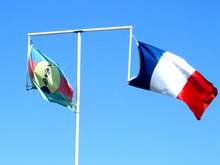Soyons unis, devenons frères
| English: Let us unite, let us become brothers | |
|---|---|
 | |
Co-national anthem of New Caledonia | |
| Lyrics | Mélodia choir, 2008 |
| Music | Mélodia choir, 2008 |
| Adopted | 18 August 2010 |
"Soyons unis, devenons frères" ("Let us unite, let us become brothers") is the officially recognised anthem of New Caledonia. It was written by a group from the children's choir Mélodia in 2008 and officially adopted in 2010. It is not the national anthem of New Caledonia; as a special collectivity of France, the national anthem is the French national anthem, "La Marseillaise". During official ceremonies or sports events, "La Marseillaise" is performed first, followed by "Soyons unis, devenons frères".[1]
History
[edit]In 1998, the Nouméa Accord delegated greater autonomy to the territory and provided that its people would ultimately have the right to vote for full independence, in 2014 at the earliest and in 2018 at the latest. In the meantime, the Accord provided for the gradual recognition of five "identity signs": an anthem, a motto, local symbols on New Caledonian currency, a flag and a potential new name for the territory.[1]
For the anthem, a competition was held by the Government of New Caledonia in 2008. The winning entry was written in January 2008 by seven New Caledonian children between the ages of 10 and 13 from the children's choral group Mélodia.[2][3] It was performed for the first time on 26 June 2008.[3]
On 18 August 2010, the Congress of New Caledonia officially adopted the anthem,[3] alongside an official motto ("Terre de parole, terre de partage"; "Land of speech, land of sharing") and local symbols on New Caledonian currency. There was not yet agreement on recognition of a flag or a new name for the territory at the time. Congress deputies reserved the possibility of amending the lyrics of the anthem at a later date.[1]
Lyrics
[edit]In its long version, the anthem consists of three verses and a chorus. The verses are sung in French; the chorus is sung in Nengone then in French. There were initial plans to translate it eventually into other indigenous languages, which were carried out in the years following the anthem's creation.[4] When only the short version of the anthem is sung, it consists of the third verse and the chorus (in Nengone and French).[5]
| Official lyrics[5][6][7] | Unofficial literal English translation |
|---|---|
I |
I |
| IPA transcription of Nengone chorus[c] |
|---|
[n̥o.re sa ɭu so ke.ʔed͡ʒ o.nom] |
Original Nengone chorus
[edit]The following is the original chorus in Nengone written by the Mélodia choir in 2008.
| Nengone original[5] | IPA transcription[c] |
|---|---|
Hnoresaluso ke'j onome |
[n̥o.re.sa.ɭu.so ked͡ʒ o.nom] |
In other languages
[edit]On 24 September 2016, for New Caledonia Day (or Citizenship Day), the Mélodia choral performed a version of the anthem that included the chorus sung in several additional languages, including indigenous languages, Chinese, Réunion Creole, Standard German, Spanish and Russian.[8]
| Iaai chorus[4][8] | IPA transcription[d] |
|---|---|
Khaca dhötin hnyatr me lakeiny hia |
[xa.cᶜ̧a ðø.t̪in̪ ɲ̊æʈᶳ me la.kei̯ɲ hi.æ] |
| Ndrumbea chorus[4][8] | IPA transcription[e] |
Tấavúu-tầâ, úì mè kéè nrèmwà-a-tíi |
[tã́ː.vúː.tã̀ː ú̯ì mè kéè ɳè.mʷà.a.tíː] |
| Drehu chorus[4][8] | IPA transcription[f] |
Casi ju së itre trejin |
[t͡ʃɑ.si ðu sæ i.ʈe ʈe.ðin] |
Notes
[edit]- ^ Sometimes written Hnore sa lu so keejo onome.[6]
- ^ Sometimes written Ha roy na ikudja ne enetho.[6]
- ^ a b See Help:IPA and Nengone language § Phonology.
- ^ See Help:IPA and Iaai language § Phonology.
- ^ See Help:IPA and Ndrumbea language § Phonology.
- ^ See Help:IPA and Drehu language § Phonology.
References
[edit]- ^ a b c "La Nouvelle-Calédonie se dote d'un hymne et d'une devise", Le Monde, 18 August 2010
- ^ "De l'écriture ... à la création". Mélodia. Archived from the original on 2008-07-12. Retrieved 2022-02-09.
- ^ a b c "Soyons Unis, Devenons Frères - l'Hymne pour la Nouvelle-Calédonie présenté par ses auteurs-compositeurs". melodia.nc. Retrieved 2022-02-10.
- ^ a b c d "Soyons Unis, Devenons Frères - l'Hymne pour la Nouvelle-Calédonie en audio et vidéo". melodia.nc. Retrieved 2022-02-10.
- ^ a b c "Soyons unis, devenons frères". Mélodia. Archived from the original on 2008-07-05. Retrieved 2022-02-09.
- ^ a b c "Partition de l'Hymne de la Nouvelle-Calédonie" (PDF). Direction de l'Enseignement de la Nouvelle-Calédonie. Retrieved 2022-02-10.
- ^ Caron, Romain. "Album Art Dans Tous Ses éTats". Calaméo. p. 22. Archived from the original on 2022-02-10. Retrieved 2022-02-10.
- ^ a b c d choralemelodia (2017-01-02). "hymne de la Nouvelle-Calédonie". YouTube. Retrieved 2022-02-10.

